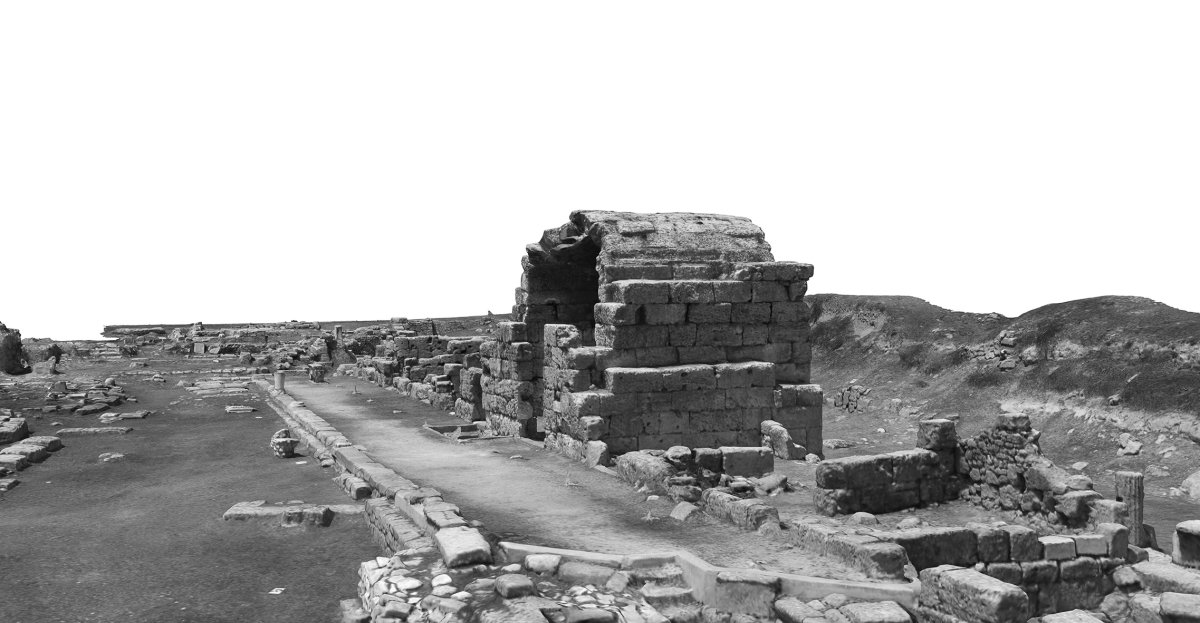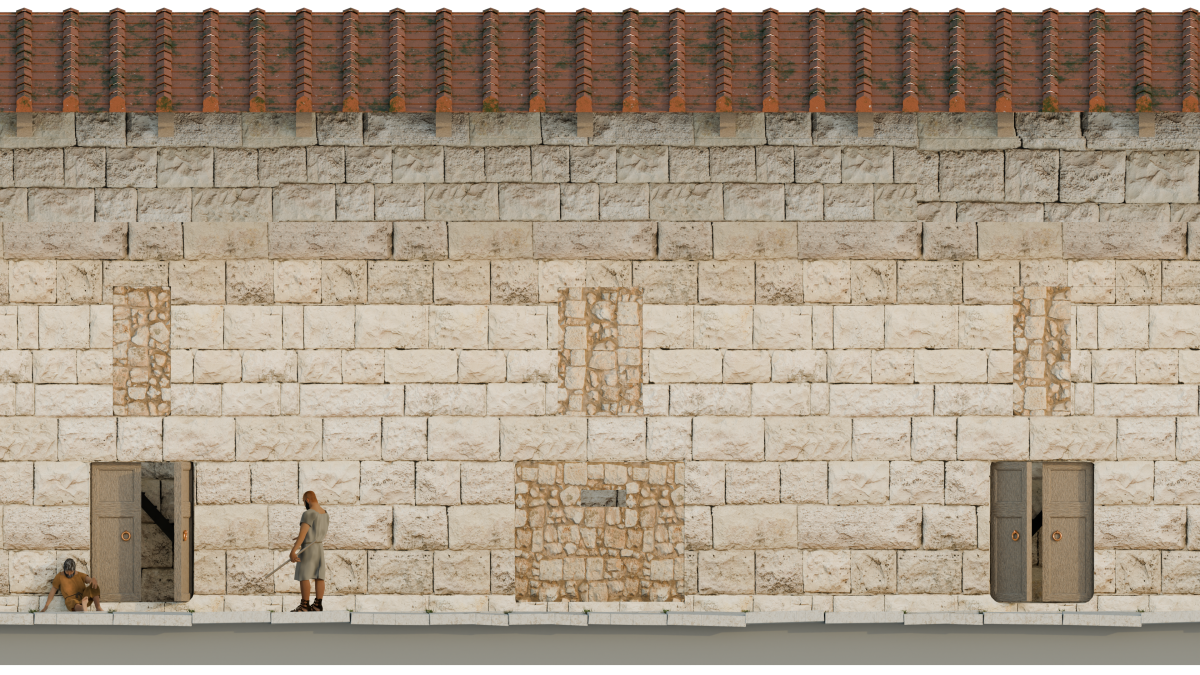A Roman prison, described as a “lawless place,” has been identified thanks to a collection of disturbing ancient graffiti, a study reported.
The site, located at the archaeological site of Corinth in Greece, appears to have been used as a place of incarceration during the Late Antique Period, according to a paper published in Hesperia: The Journal of the American School of Classical Studies at Athens.
Corinth was an ancient city-state that became one of the largest and most important Greek settlements in antiquity. The city was captured and almost completely destroyed by Roman forces in 146 B.C., remaining largely deserted for more than a century. It was only in 44 B.C. when Roman general and politician Julius Caesar reestablished the city as a provincial capital that it began to recover.

One of the floor tiles featuring graffiti from the Late Antique prison in ancient Corinth, Greece. Inscriptions like these were made by prisoners, shedding light on the experience of their incarceration.
P. Dellotas/Courtesy of Corinth Excavations
Corinth underwent a series of renovations during the late 4th-early 5th century, and the structures that served as the prison were among those affected by the works. The structures appear to have been repurposed and renovated at the end of the 4th century, when the site was transformed into a prison, according to the study.
The structures were used to incarcerate people for at least a couple more centuries after that, if not more, study lead author Matthew Larsen with the University of Copenhagen, Denmark, told Newsweek.
Documented evidence of such an incarceration site from antiquity is significant, given the rarity of such finds.
“I have been working, along with several colleagues, on the history and archaeology of ancient Mediterranean incarceration for eight years. The archaeological remains of prisons have proven exceedingly elusive and hard to identify with certainty,” Larsen said.
The ancient prison lies within the site of Corinth’s Roman forum, located in the heart of the city. In Roman cities, the forum was a multipurpose public square or open area usually found in a central location. It served as a gathering place, as well as a kind of marketplace. But it also had other purposes, hosting political debates and other activities.
Larsen was able to identify the ancient prison in a part of the forum referred to as “Boudroumi and the Northwest Shops.”
“Boudroumi is a Turkish loanword for ‘dungeon’ and was used by the local population in Corinth in 1901 to describe the building, of which only the top of the vaulted arch roof was visible,” Larsen said. “The northwest shops are a row of 15 rooms, opening up to the forum, with the boudroumi as the central room. It is slightly larger than the other 14 rooms.”
The rooms likely had a commercial function in the first centuries of their use. Then after an earthquake at the end of the 4th century, they were totally renovated into a prison, according to the researcher.
Larsen was able to identify these structures as a prison, in large part, thanks to the graffiti found on floor tiles in the area.




A model showing the area of ancient Corinth where the prison was identified. The prison lies within the site of Corinth’s Roman forum, located in the heart of the city.
Photography by J. Herbst and M. Letteney; model by M. Letteney/Courtesy of Corinth Excavations
“When I found out about these graffiti…I immediately thought, if we can prove exactly where these floor tiles were found, and if they were in situ—i.e. not floating or deposited there but the in-place flooring—then we could securely ID the site as a prison,” he said.
“We know from the 1901 excavation reports that the floor tiles were in their original renovated position as the floor of the boudroumi and northwest shops. We also know they were installed, reused from another place, as they were broken on one or many sides.”
The graffiti appears to have been inscribed on the tiles by prisoners. Some record phrases in which the prisoners beg to be released, while others ask for “no mercy” for the people who incarcerated them.
Among the graffiti that Larsen highlights are the following phrases:
- “May the fortune of those who suffer in this lawless place prevail. Lord, do not show mercy on the one who threw us in here.”
- “Lord, make them die an awful death.”
There are also graffiti that asks for good fortune for beautiful women who love unmarried prisoners, several game boards and one design of what appears to be a soldier. There was also lots of graffiti on the walls, though only scarcely preserved now.
The graffiti was created by prisoners in a way that observed the broken edges of the floor tiles. This indicates that the inscriptions can be dated to the site’s phase of use as a prison.




A reconstruction showing what the Late Antique prison in ancient Corinth may have looked like. The rooms likely had a commercial function prior to being renovated in the 4th century.
Reconstruction by Niels Bargfeldt/Supported by the Carlsberg Foundation
“When I set out to try to identify remains of prisons, I knew it would be hard and I jokingly said, ‘It’s not like prisons are the kind of place that will just have an inscription identifying it [as such]’—but this is almost just as clear evidence as that, which was surprising to me,” Larsen said.
Larsen is currently leading a research project that is attempting to develop a classification system for Roman prisons, and is also working on a monograph with colleague Mark Letteney about ancient Mediterranean incarceration.
“We are part of a growing wave of historians who demonstrate that, while the prison is often explained as a modern invention, our research holds a mirror to the present and confronts us with a longer, more complicated history than some had previously acknowledged,” Larsen said.
Do you have a tip on a science story that Newsweek should be covering? Do you have a question about archaeology? Let us know via science@newsweek.com.
References
Larsen, M. D. C. (2024). A Prison in Late Antique Corinth. Hesperia: The Journal of the American School of Classical Studies at Athens, 93(2), 337–379. https://doi.org/10.2972/hes.2024.a929939
This post was originally published on this site be sure to check out more of their content.









